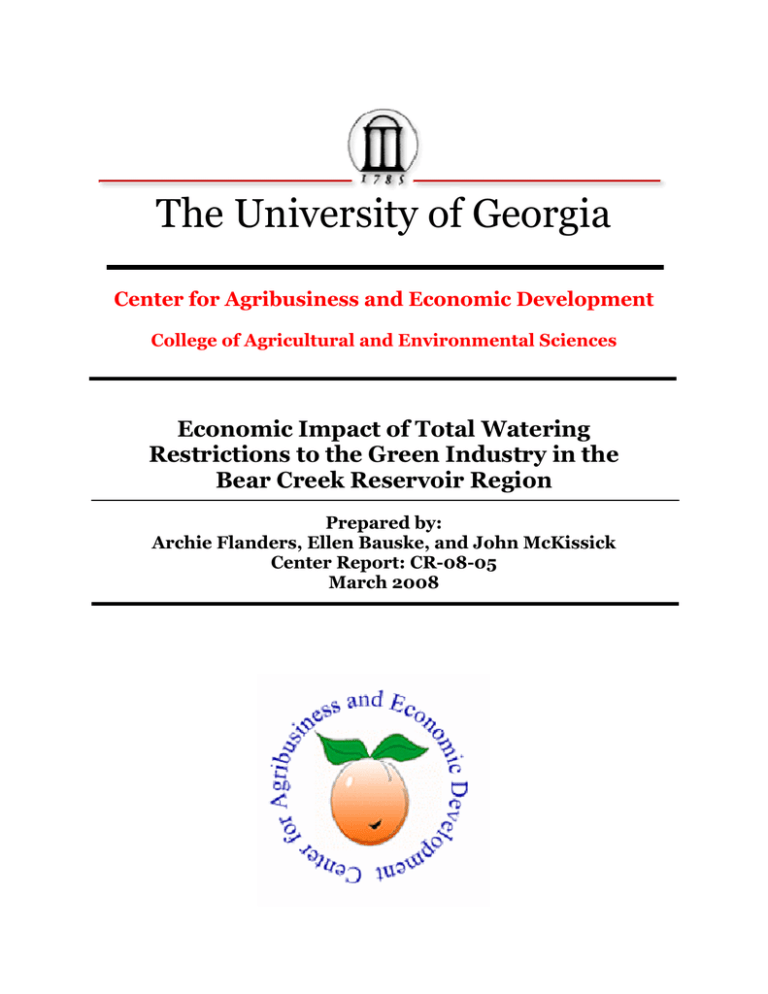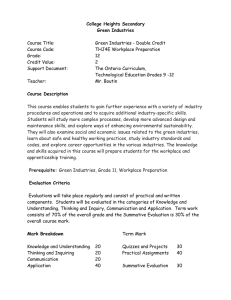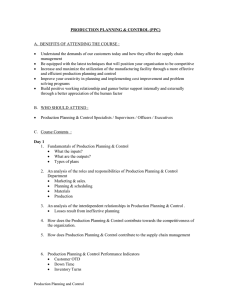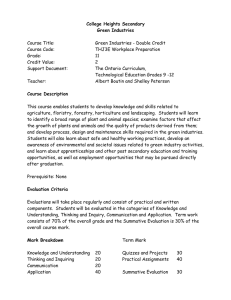The University of Georgia
advertisement

The University of Georgia Center for Agribusiness and Economic Development College of Agricultural and Environmental Sciences Economic Impact of Total Watering Restrictions to the Green Industry in the Bear Creek Reservoir Region Prepared by: Archie Flanders, Ellen Bauske, and John McKissick Center Report: CR-08-05 March 2008 Economic Impact of Total Watering Restrictions to the Green Industry in the Bear Creek Reservoir Region Executive Summary Barrow, Clarke, Jackson, and Oconee Counties compose the Bear Creek Reservoir Region. The green industry in the region is composed of three sectors. Theses sectors are nursery and greenhouse production, landscape services, and retail sales. Purchases of inputs within the region create secondary economic activity, while wages earned by employees lead to spending in all sectors of the economy. Total watering restrictions in the region will limit economic activity that is associated with the green industry. Losses in greenhouse and nursery production lead to a total economic output impact loss of $25.3 million in the regional economy. A total of 231 jobs lost that are related to the production industry lead to a reduction of $12.0 million in wages and benefits. Local governments lose $418,851 in tax revenues due to greenhouse and nursery production declines. Economic output impacts due to declines in landscape services total $39.8 million. Wages and benefits lost are $15.8 million for 584 jobs associated with landscape services. Local governments in the region lose $853,301 in tax revenues due to decreased sales in landscape services. Losses in retail sales of greenhouse and nursery products, as well as related supplies result in $91,824 of lost wages and benefits for 2 jobs, for each $1.0 million of expected retail sales that would occur in normal watering conditions. In addition to the direct sales taxes associated with sales, each $1.0 million of expected retail sales lost leads to a $15,416 decrease of local tax revenues in the region. Economic Impact of Total Watering Restrictions to the Green Industry in the Bear Creek Reservoir Region Barrow, Clarke, Jackson, and Oconee Counties compose the Bear Creek Reservoir Region. The green industry in the region is composed of three sectors. Theses sectors are nursery and greenhouse production, landscape services, and retail sales. The 2006 farm gate value of production reported by the Center for Agribusiness and Economic Development (CAED) at the University of Georgia is $48.2 million. Landscape services including installation and maintenance totaled $42.2 million of sales in 2006. Production of plant material, landscape services, as well as retail sales are a stimulus to the entire region. Purchases of inputs within the four counties create secondary economic activities, while wages earned by employees lead to spending in all sectors of the regional economy. Total watering restrictions in the region will limit economic activity that is associated with the green industry. A survey conducted by the Center for Urban Agriculture at the University of Georgia estimates percentage losses in revenue for each of the three green industry sectors due to total watering restrictions in 2008. Survey results indicate that production revenue will decline by 37% and landscape services will decline by 59%. Total watering restrictions will cause a reduction of 58% in retail sales. The objective of this report is to determine the total economic impacts to the Bear Creek Reservoir Region that would occur under circumstances of total watering restrictions. Principles of Economic Impact Analysis Economic impacts can be estimated with input-output models (IMPLAN) that separate the economy into various industrial sectors such as agriculture, construction, manufacturing, trade, and services. An input-output model calculates how a change in one industry changes output, income, and employment in other industries. These changes, or impacts, are expressed in terms of direct and indirect effects. Impacts are interpreted as the contribution of the enterprise to the total economy. Direct effects represent the initial impact on the economy of either construction or operations of an enterprise. Indirect effects are changes in other industries caused by direct effects of an enterprise and include changes in household spending due to changes in economic activity generated by direct effects. Thus, the total economic impact is the sum of direct and indirect effects. Input-output analysis can interpret the effects of an enterprise in a number of ways including output (sales), labor income (employee compensation and proprietary income), employment (jobs), and tax revenue. Economic impacts result from a multiplier effect that begins with expenditures of an enterprise stimulating business to business spending, personal income, employment, and tax revenue. IMPLAN models include a regional purchase coefficient (RPC) for each impact variable that represents percentage of demand that is satisfied by production within an impact area. Demand for inputs not satisfied within the impact area represent leakages that have no indirect impacts in the impact area. Enterprises vary in their multiplier effects due to differing expenditure levels, RPC’s, and sectors in which their expenditures are directed. Impact analysis involves quantification of spending levels and proper allocation to impacted sectors. 1 Output impacts are a measure of economic activity that results from expenditures in a specific industrial sector. Output is equivalent to sales, and this multiplier determines how initial economic activity in one sector leads to sales in other sectors. Personal income impacts measure purchasing power that is created due to the output impacts. This impact provides the best measure of how standards of living are affected for residents in the impact area. An enterprise involves a specified number of employees that is determined by the technology of the enterprise. Employment multipliers indicate the effect on employment resulting from the enterprise initiating economic activity. IMPLAN indirect employment includes both full-time and part-time jobs without any distinction. Jobs calculated within an IMPLAN industrial sector are not limited to whole numbers and fractional amounts represent additional hours worked without an additional employee. With no measure of hours involved in employment impacts, IMPLAN summations for industrial sectors which include fractional employment represent both jobs and job equivalents. Since employment may result from some employees working additional hours in existing jobs, instead of terming indirect employment impacts as “creating” jobs, a more accurate term is “involving” jobs or job equivalents. Economic Impacts of Greenhouse and Nursery Production Losses Applying the percentage loss in production to the 2006 value leads to $17.6 million of direct sales losses in Table 1. These losses lead to losses in indirect sales in the regional economy that creates a total output impact of $25.3 million. Job losses include 156 employees and proprietors directly employed in production with a total of $9.7 million in wages and benefits. Indirect employment losses for 75 jobs total $2.4 million in wages and benefits. Total income declines by $12.0 million for 231 jobs in the region. Total Georgia tax revenues lost due to production declines are $1.3 million with $418,851 of this loss to local governments in the Bear Creek Reservoir counties. Appendix 1 shows the distribution of impact losses by major industrial sectors. Table 1. Economic Impacts of Green Industry Production Losses, Bear Creek Reservoir Region, 2008 Direct Indirect Total Impact Impact Impact Output ($) 17,576,976 7,732,885 25,309,861 Labor Income ($) 9,661,974 2,362,332 12,024,306 Employment 156 75 231 State Taxes ($) 862,295 Local Taxes ($) 418,851 Economic Impacts of Landscape Service Losses Residences and commercial developments create a demand for landscape services in the Bear Creek Reservoir Region. Applying the percentage loss to the 2006 output value for landscape services leads to direct losses of $25.0 million in Table 2. Indirect sales losses related to 2 landscape services are $14.8 million for a total output impact of $39.8 million. A total of 424 employees and proprietors directly involved in landscape services lose $10.9 million in wages and benefits. Losses in indirect employment for 160 jobs totals adds $4.9 million of earned income. Total wages and benefits lost for 584 jobs related to landscape services are $15.8 million. Local governments in the region lose $853,301 in tax revenue. The state of Georgia loses $1.3 million in tax revenue. Appendix 2 shows the distribution of impact losses among the major sectors in the regional economy. Table 2. Economic Impacts of Landscape Service Losses, Bear Creek Reservoir Region, 2008 Direct Indirect Total Impact Impact Impact Output ($) 25,002,136 14,816,192 39,818,328 Labor Income ($) 10,888,166 4,941,831 15,829,997 Employment 424 160 584 State Taxes ($) 1,263,527 Local Taxes ($) 853,301 Economic Impacts of Retail Sales Aggregated data for a combination of building materials, garden equipment, and garden supplies indicates 2006 sales in the region of $378.8 million (The Georgia County Guide, CAED). Data is not available for the value of retail sales of garden supplies in the Bear Creek Reservoir Region. Table 3 presents the economic impacts attributable to the retail margins associated with each $1.0 million in garden supply sales after accounting for the expected reduction in sales (58%) due to total watering restrictions. The total output impact is $247,823 in losses. Total employee and proprietor wages and benefits are $91,824 for 2 total jobs. Tax revenues in Table 3 include only those associated with the impacts of retail margins. Tax revenues associated with direct sales taxes are calculated by multiplying total retail sales by the average regional tax rate. Table 3. Economic Impacts of Garden Supply Stores, Retail Margins for $1,000,000 in Expected Sales, Bear Creek Reservoir Region, 2008 Direct Indirect Impact Impact Output ($) 161,575 86,248 Labor Income ($) 64,287 27,537 Employment 1 1 Total Impact 247,823 91,824 2 1 State Taxes ($) 15,121 1 Local Taxes ($) 15,416 1 Does not include direct sales taxes on retail purchases. Multiply $575,000 by applicable tax rate for direct sales taxes. 3 Summary Total watering restrictions in the Bear Creek Reservoir Region will lead to economic losses in sectors composing the green industry. These direct losses in the green industry will have negative economic impacts throughout the region. Losses in greenhouse and nursery production lead to a total economic output impact loss of $25.3 million in the regional economy. A total of 231 jobs lost that are related to the production industry lead to a reduction of $12.0 million in wages and benefits. Local governments lose $418,851 in tax revenues due to greenhouse and nursery production declines. Economic output impacts due to declines in landscape services total $39.8 million. Wages and benefits lost are $15.8 million for 584 jobs associated with landscape services. Local governments in the region lose $853,301 in tax revenues due to decreased sales in landscape services. Losses in retail sales of greenhouse and nursery products, as well as related supplies result in $91,824 of lost wages and benefits for 2 jobs, for each $1.0 million of expected retail sales that would occur in normal watering conditions. In addition to the direct sales taxes associated with sales, each $1.0 million of expected retail sales lost leads to a $15,416 decrease of local tax revenues in the region. 4 Appendix 1. Green Industry Production Losses, Economic Impacts to Major Sectors, Bear Creek Reservoir Region, 2008 Labor Sector Output ($) Income ($) Employment Agriculture 17,643,754 9,693,403 158 1 MC 53,371 21,486 1 Utilities 307,632 66,866 1 Manufacturing 615,493 98,589 2 Transportation, Warehousing 255,961 120,930 3 Trade 1,628,230 645,928 20 2 FIRE 1,066,303 234,348 7 Services 2,530,933 1,110,433 39 Government & Non NAIC's 1,208,184 32,323 1 Total 25,309,861 12,024,306 231 1 Mining and Construction 2 Finance, Insurance, and Real Estate Appendix 2. Landscape Service Losses, Economic Impacts to Major Sectors, Bear Creek Reservoir Region, 2008 Sector Agriculture MC1 Utilities Manufacturing Transportation, Warehousing Trade FIRE2 Services Government & Non NAIC's Total 1 Mining and Construction 2 Finance, Insurance, and Real Estate Output ($) 42,344 89,869 349,643 804,983 558,435 4,258,342 1,955,315 30,159,625 1,599,772 39,818,328 5 Labor Income ($) 9,792 36,266 75,474 137,016 258,019 1,702,957 427,798 13,124,615 58,059 15,829,997 Employment 0 1 1 3 6 56 12 503 1 584 The Center for Agribusiness & Economic Development The Center for Agribusiness and Economic Development is a unit of the College of Agricultural and Environmental Sciences of the University of Georgia, combining the missions of research and extension. The Center has among its objectives: To provide feasibility and other short term studies for current or potential Georgia agribusiness firms and/or emerging food and fiber industries. To provide agricultural, natural resource, and demographic data for private and public decision makers. To find out more, visit our Web site at: http://www.caed.uga.edu Or contact: John McKissick, Director Center for Agribusiness and Economic Development Lumpkin House The University of Georgia Athens, Georgia 30602-7509 Phone (706)542-0760 caed@agecon.uga.edu The University of Georgia and Fort Valley State University, and the U.S. Department of Agriculture and counties of the state cooperating. The Cooperative Extension Service offers educational programs, assistance and materials to all people without regard to race, color, national origin, age, sex or disability. An equal opportunity/affirmative action organization committed to a diverse work force. Report Number: CR-08-05 March 2008 Issued in furtherance of Cooperation Extension Acts of May 8 and June 30, 1914, the University of Georgia College of Agricultural and Environmental Sciences, and the U.S. Department of Agriculture cooperating. J. Scott Angle, Dean and Director






